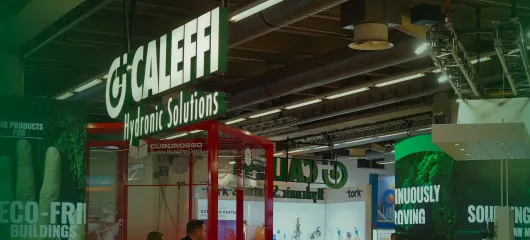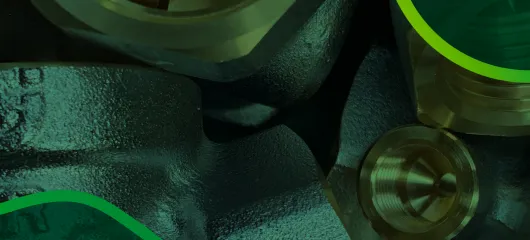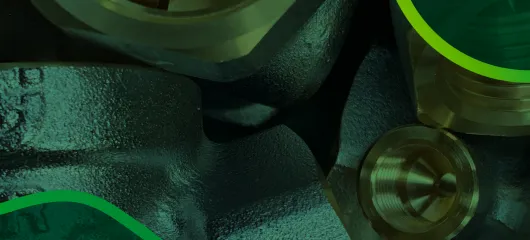INDUSTRY 4.0: CALEFFI BECOMES A SMART FACTORY
Nowadays, everyone is talking about Industry 4.0. and Caleffi is no exception. Here we tell you how.
"The fourth industrial revolution is the awareness of the potential use of digital technologies to improve processes”. These are the words of Marco Taisch, Professor of Advanced and Sustainable Manufacturing and Operations Management of the Politecnico di Milano and Scientific Chairman of the World Manufacturing Forum 2016.
Nowadays, everyone is talking about Industry 4.0. and Caleffi is no exception. Here we tell you how. But first, a brief introduction to what’s going on.
In just a couple of centuries, we’ve seen three industrial revolutions:
- the first came with the introduction of steam and coal machinery;
- the second with the spread of electricity and oil and the idea of work standardisation;
- the third, most recent revolution involved the introduction of PLC technologies with programmable electronic systems and computers to manage factories and product lifecycles.
It was in these years that the fourth era began, underpinned by the Internet, in the broadest sense, with a widespread digital transformation. So, the fourth industrial revolution lies in the ability of companies to exchange data and support the interaction of intelligent machines and people in the most efficient way possible, not only within the companies but by engaging the entire value chain as a whole. Underlying everything is the concept of the Cyber Physical System (CPS), which was the result of the sensorisation of systems and their individual elements (IoT) combined with the ability to create a virtual model (Digital twin), that makes it possible to monitor, understand and simulate behaviour in different scenarios in order to achieve automated control and make real-time adjustments.
Italy is the number two manufacturer in Europe (and in the top ten worldwide), and is now facing a governmental agenda that is quite complex but is beginning to show positive results: regulations governing corporate investment have been absorbed by financial law and are already operational in most cases (e.g. super- and hyper-amortisation on the purchase of machinery and digitisation).
In this scenario, companies cannot sit tight: they must actively implement the Smart Factory concept: a factory with data flows from various sources, which are then incorporated to synchronise customer order processes with the supplies across the Internet of things (with sensorisation, first and foremost) and Cloud Computing with its on-demand, multi-platform and multi-device features. In other words, in production environments, physical machines interconnected through sensors, actuators and a network will be capable of producing information, whereby various scenarios of options will be developed and the most suitable choice will be suggested. This is essentially a production model where only what is actually ordered from the market will be produced, integrating artificial and human resources in a flexible and adaptable system.
So, what about Caleffi? Caleffi aims to gradually achieve these targets, step by step.
In 2013, a broad project to modernise operations was developed and approved in its key aspects: management (production planning), productions processes (their design and optimisation) and operating procedures (modernisation of production processes, with new machinery and systems and with a parallel investment in staff training). For each of these areas, specific project plans were launched, involving more than 500 people from Operations, and now CALEFFI is truly making its way into the age of Industry 4.0.
The mechanical processes of the Fontaneto d’Agogna plant have been completely redesigned and adapted for this evolutionary leap, with a redevelopment project of 10 thousand square metres worth of production area and a total investment of 25 million Euro. Indeed, ‘redevelopment’ may be an understatement: rather, it is a full restructuring of the company’s core machining process. It all started with a very simple yet fundamental consideration: the youngest operational machine (among more than 100) was more than 10 years old. The results were still coming, but way too slowly for our standards and for a fast-changing market in terms of needs and dynamics. We didn't want our production resources to soon be underused or, worse, unusable. For example, product batches that were regarded as “commodities” declined in volume (in response to market demand), while we were starting to make more and more complex products, such as distributors, dirt separators and satellites, which have a drastically different production impact and require brand-new raw materials our machines were unable to manage.
We started to grapple with this problem back in 2012, when a revolution in another production plant (dedicated to moulding plastics) provided design and technical/technological expertise in terms of advanced automation, which has taught us a great deal in view of transforming the central plant into a Smart Factory over time. We saw first-hand how not only machines, their layout and the automated replenishment of raw materials were key elements – which was quite obvious – but the management of ‘surrounding’ elements, such as tooling methods and the fact that operators were always aware of what was going on during the production process, were also critical.
But the systems are even more critical: the MRPII (Manufacturing Resource Planning) platform, worth 1 million Euro, has been introduced as part of a project that started in 2013 and went live in January 2015. This platform was integrated into MES (Manufacturing Execution Systems) and APS (Advanced Planning and Scheduling), key applications to achieve a Smart Factory (bear in mind that the financial benefits are based on strict requirements, such as the existence of an MES). The MES essentially provides an insight into each stage of the production process almost in real time by collecting and processing data from people and machines in a fully sensor-based and computerised way.
An interesting and very practical aspect of the whole project is a technical/organisational area that seems to be less important, but is actually key for those who deal with production first-hand: tooling management. To resolve this critical situation, steps were taken to introduce full supervision of the equipment in terms of stock and application, integrating it into another company legacy system, the PLM, to manage the Process Plan of several new management identities. By knowing which tools are needed for each material code in production, supply lists were created and associated with the production order, and they were automatically sent to the warehouse. To sum up, when opening the order, the product code (which has a series of features) tells the system which raw materials to supply, the tools needed, the specific wash programme (where applicable), the scrap management procedure, the part count for each collection box, while automatically preparing and configuring the machines and equipment for production. The process is constantly monitored, telling us – as accurately as possible – if a specific batch is available in the warehouse, thereby making it possible to arrange shipments to customers with greater precision than ever before. Considering the integration with the – already more than efficient – Vertical Warehouse, the benefits to customers will grow exponentially: they can count on a timely delivery of the order, without having to create a time-consuming stock at their site.













